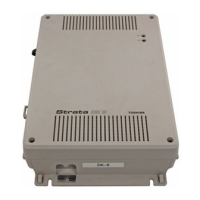INSTALLATION-PERIPHERALS
SECTION 100-816-207
MARCH 1993
7-38
1) Consult the serial printer’s documentation and
determine if the printer operates as a DCE or
DTE device:
•
If the printer is a DCE device: Disas-
semble the PDIU-DS and configure it to
operate like a DTE device by placing the
jumper plugs (P1 ~ P9) in the “B-C”
(MODEM) position. Reassemble the
PDIU-DS, and mark “B-C” on the bottom
identification label for future reference.
(Paragraph 10.70 provides PDIU-DS dis-
assembly/assembly instructions, and Fig-
ure 7-31 provides jumper plug informa-
tion.)
•
If the printer is a DTE device: It may not
be necessary to disassemble the PDIU-
DS, since it comes direct from the factory
configured as a DCE device. However, if
uncertain, disassemble the PDIU-DS and
verify that jumper plugs (P1 ~ P9) are in
the “A-B” (DTE) position. Reassemble
the PDIU-DS and mark “A-B” on the
bottom identification label for future ref-
erence. (Paragraph 10.70 provides
PDIU-DS disassembly/assembly instruc-
tions, and Figure 7-31 provides jumper
plug information.)
2) Connect the PDIU-DS to the appropriate digi-
tal telephone circuit per wiring diagrams in
Section100-816-208 and information provided
in Section 100-816-206.
3) Connect the appropriate RS-232 cable be-
tween the printer and the PDIU-DS (see Fig-
ure 7-27 and 7-29 for an example printer
cable connection).
4) If steps 2 and 3 are done properly, the Power
and Ready LEDs on the PDIU-DS should light
when the printer is turned on and ready.
5) Set the PDIU-DS DIP switch (SW1-1 ~ 4) for
the desired application. Figure 7-32 shows the
DIP switch locations and Paragraph 10.30
describes switch functions.
NOTE:
If using Toshiba computers and printers with
X-On/X-OFF flow control, set SW1-(4) “ON”
on the DIU connected to the computer and
DIU connected to the printer.
IMPORTANT NOTE!
Check the printer’s serial documentation
for correct RS-232 pin requirements. The
requirements vary with each manufacturer.
6) Use Program 20 to configure the PDIU-DS to
connect to a serial printer (see Programming
Section 100-816-302 for instructions and
record sheets).
•
LED 01: Should always be ON for PDIU-
DS ports.
•
LED 02: Should be OFF for PDIU-DS
ports connected to printers.
•
LED 03: Should be OFF for PDIU-DS
ports that connect to DTE- or DCE-type
printers.
•
LED 04: Should always be ON for PDIU-
DS ports.
•
LED 05: Should be OFF for PDIU-DS
ports connected to printers.
•
LEDs 17 ~ 20: Data security groups can
be used to allow or deny digital tele-
phones equipped with PDIU-DIs access
to PDIU-DS ports connected to a printer.
DIU stations can only make data calls to
DIUs in the same data security group.
7) Program 22 should be used to configure
PDIU-DSs to hunt if more than one PDIU-DS
connected to the same printer/server.
10.60 PDIU-DS to Modem Installation
10.61 STRATA DK16 enables asynchronous-type
(not synchronous) modems to be connected to
PDIU-DSs. This allows PDIU-DI equipped digital
telephones that are connected to personal comput-
ers, terminals, and other devices to share access to
a modem or modem pool.

